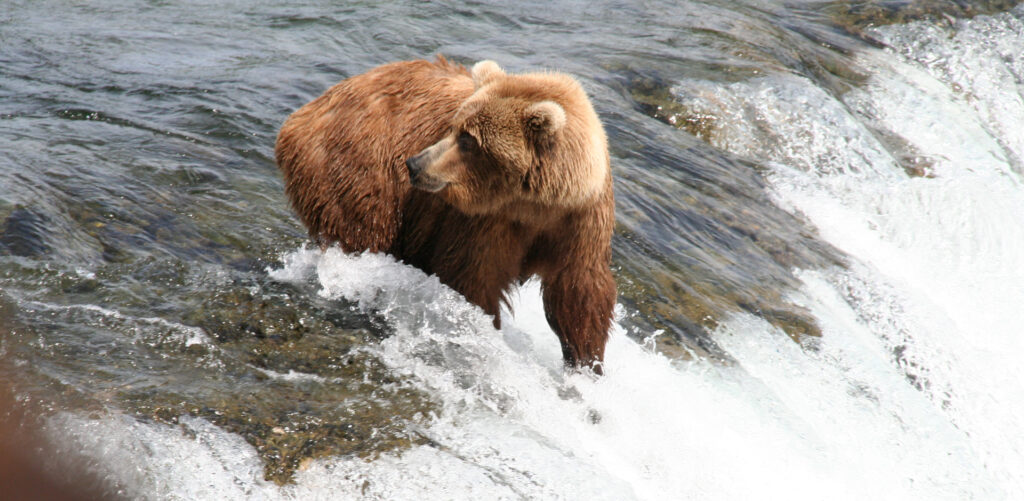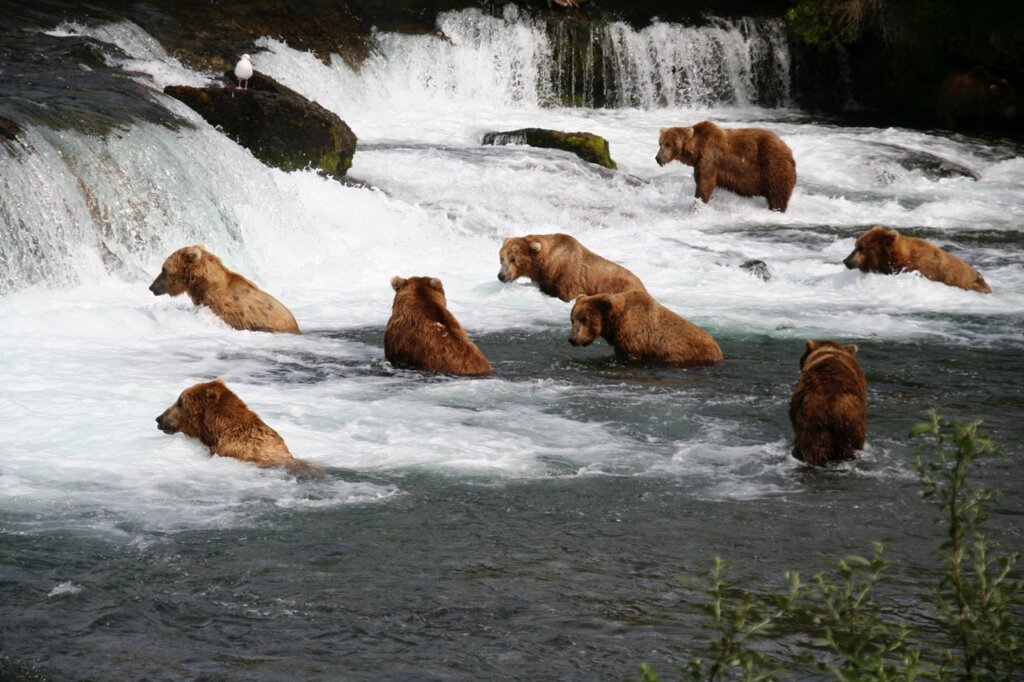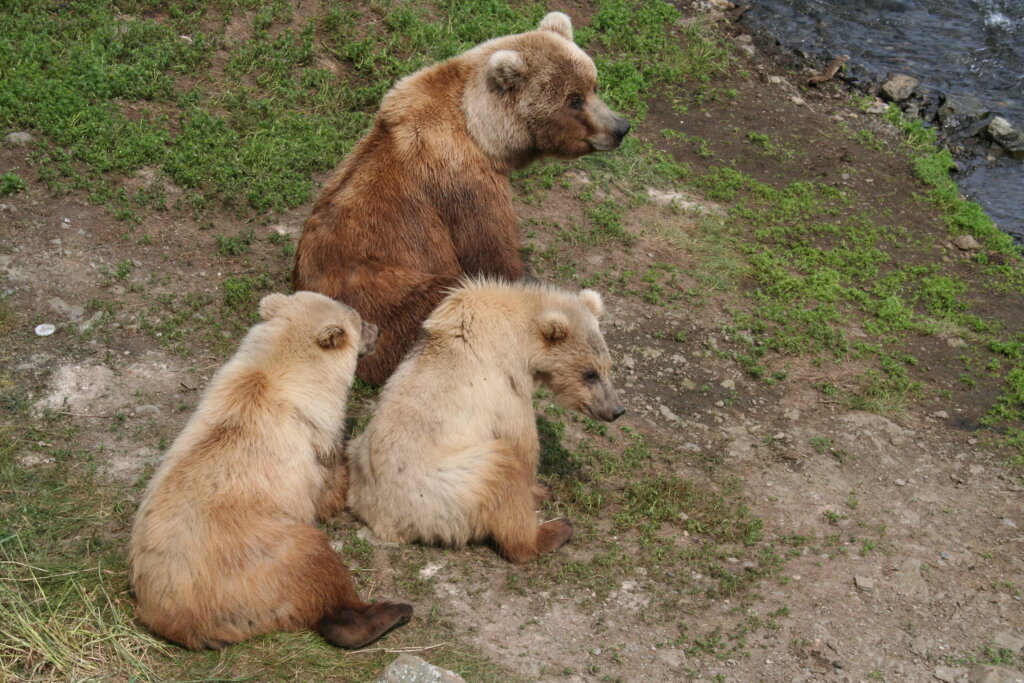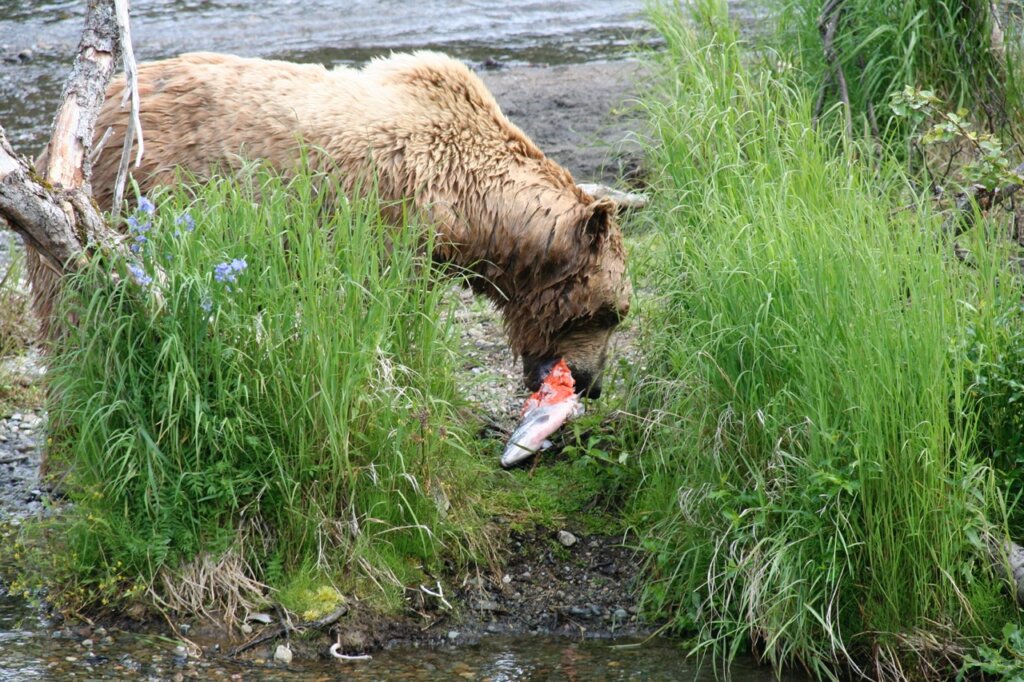Alaska – 3 Bears in Alaska ( 2007 ) Last Updated: February 27, 2022

This second visit to Alaska was exclusively planned to see Brown bears during Salmon run. It was inspired by a show on Discovery channel showing bear viewing around McNeil River in SE Alaska. That trip was quite strenuous, requiring living in tents.
My husband knew about the gathering of Bears during Salmon run.
So after some Google search I found a location more suitable for us and decided to go to Katmai National Park located on SW coast of Kenai Peninsula. This national park is famous for two things – Salmon run and Valley of thousand smokes.
Katmai National Park has three locations for stay. We found Brooke’s lodge as the most convenient location to stay for us to visit. The park has at least 3 different lodges but Brooks Lodge was easiest to reach from King Salmon airport.
After staying for one night at a convenient hotel in Anchorage we flew to King Salmon.
Brooks Lodge is a popular accommodation option near Katmai National Park, specifically located in Katmai National Park and Preserve, Alaska. It is situated near the renowned Brooks Falls, known for the spectacular bear viewing opportunities during the salmon runs. Brooks Lodge is a a prime location for bear viewing, to witness the iconic brown bear fishing at Brooks Falls, in the park. The lodge is well-known for its bear-watching platforms and the unique opportunity it provides to observe these majestic animals in their natural habitat.
A salmon run is an annual fish migration event where many salmonid species, which are typically hatched in fresh water and live most of their adult life downstream in the ocean, swim back against the stream to the upper reaches of rivers to spawn on the gravel beds of small creeks. After spawning, all species of Pacific salmon and most Atlantic salmon die,[1] and the salmon life cycle starts over again with the new generation of hatchlings.
Best time to visit is around August for about 6 weeks. At this time of the year Salmon is swimming up the river in which it was born. This is known as Salmon run. This lasts for about 6 weeks. At this time of the year bears gather around appropriate location at the river’s edge to catch the Salmon. This continues for six weeks, during which bears are waiting to catch the Salmon. If U are late U will see a gathering of vultures feasting on dead Salmon.
We were not lucky to get accommodation in the park at Brooke’s lodge.
So we had made a reservation to stay in this town at a home stay for 3 nights.
Surprisingly the lady whose home stay we chose was working at the Airport. She picked us up and took us home. We had a separate unit with simple cooking facilities.
We had a package for two visits to the park. Every morning she drove us to the office of Katmai National park.
After finishing the formalities we were taken by a bus to the river to board a small seaplane to fly into the park at Brookes Lodge. It was hardly 20 -30 minutes away.
From here the bus took us to the river for boarding a SEA PLANE. On boarding the sea plane and flying across the river we reached the head quarters of the Brooke’s lodge.

On landing we saw some bears at the edge of the river and instinct was to run and start taking pictures. Just where we landed a bear was close to the river and I ran to take photograph though we were instructed not to go near the bears. We were taken to the office and a preliminary talk gave us the idea of what we will see. And strict instructions about what to do and what not to do. The most important point emphasized was that bears can be dangerous and in the park Bears have the right of the way. After the talk we were made to wait for a while as they had a message that a bear is bear was going along on our road to the platform. At Brookes Lodge a platform has been constructed for viewing. So our bus took us to this spot.

On reaching the platform it was a feast for the eye, as there were several bears standing in the water waiting to catch the salmon fish. There were large bears and small ones and also a Mama with two babies. One could spend hours clicking photos and watching bears catching the fish. Later we were brought back for lunch.

Those Salmons that escape the bears go upstream and die after spawning. If you are late you will see a gathering of vultures feasting on dead Salmon
This visit was a learning experience for me, both about bears and Salmon and ecology.
I like to say a few things about role played by Salmon & Bears in Ecology of Alaska.
BEARS
There are 3 varieties – Brown bears, Black bears , Polar bears.
- Both brown bears and polar bears are huge in size. Brown bears are heavier while Polar bears are longer in size.
- Brown bears and Black bears are seen in upper reaches of temperate zone
- Polar bears seen beyond Arctic line
Grizzly bears function as ecosystem engineers, capturing salmon and carrying them into adjacent wooded areas. There they deposit nutrient-rich urine and feces and partially eaten carcasses. It has been estimated that bears leave up to half the salmon they harvest on the forest floor, in densities that can reach 4,000 kilograms per hectare, providing as much as 24% of the total nitrogen available to the riparian woodlands. The foliage of spruce trees up to 500 m (1,600 ft.) away from a stream where grizzlies fish for salmon have been found to contain nitrogen originating from fished salmon.[2]
Salmon fish is a favorite food of bears.
They eat a lot of fish during ‘Salmon Run’ in summer. This helps them to put on weight, which serves as food reserve during winter months.
Thus bear watching is intricately related to life cycle of Salmon.
Salmon
There are several varieties of Salmon in temperate zone.
- Mainly – Pacific and Atlantic salmon
- There are a few fresh water salmon also.
Life cycle of Pacific salmon
The interesting thing about life cycle of Salmon is that
- Baby salmon is born in fresh water streams in Alaska
- It stays in fresh water streams for 3-4 year & when mature it enters the sea
- It stays in the sea for 3-5 years.
- When it is ready to procreate it returns to same fresh water streams to lay eggs.
- It swims upstream against the flow of water and eggs are laid in freshwater streams typically at high latitudes.
After laying the eggs adult salmon dies.
If U visit these streams late in season U will sea floating dead fish
In the Pacific Northwest and Alaska, salmon is a keystone species, supporting wildlife from birds to bears and otters. The bodies of salmon represent a transfer of nutrients from the ocean, rich in nitrogen, sulfur, carbon and phosphorus, to the forest ecosystem.
Salmon continue to surprise us, showing us new ways in which their oceanic migrations eventually permeate entire terrestrial ecosystems. In terms of providing food and nutrients to a whole food web, we like to think of them as North America’s answer to the Serengeti’s wildebeest.
The upper reaches of the Chilkat River in Alaska have particularly good spawning grounds. Each year these attract a run of up to half a million chum salmon. As the salmon run up the river, bald eagles arrive in there thousands to feast at the spawning grounds. This results in some of the world’s largest congregations of bald eagles. The number of participating eagles is directly correlated with the number of spawning salmon.
Residual nutrients from salmon can also accumulate downstream in estuaries. A 2010 study showed the density and diversity of many estuarine breeding birds in the summer “were strongly predicted by salmon biomass in the autumn.” Salmon provides nutrients to these “diverse assemblages … ecologically comparable to the migrating herds of wildebeest in the Serengeti.

